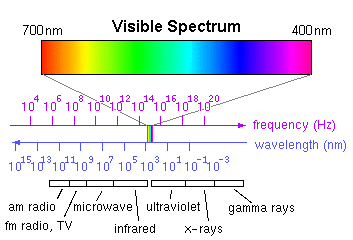
We perceive electromagnetic energy having wavelengths in the range 400-700 nm as visible light. The perceived color of visible light is as much psychological as it is physical.
The electromagetic spectrum

The following is a potential spectral energy distribution of light reflecting from a green wall

In order to understand color perception we first discuss the structure of the eye.

The photosensitive part of the eye is called the retina. The retina is largely composed of two types of cells, called rods and cones, as shown below. Only the cones are responsible for color perception. Cones are most densely packed within a region of the eye called the fovea.
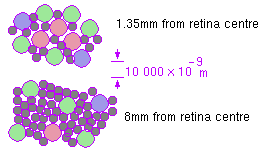
There are three types of cones, referred to either as S, M, and L, which are roughly (very roughly) equivalent to blue, green, and red sensors, respectively. Their peak sensitivities are located at approximately 430nm, 560nm, and 610nm for the "average" observer. Colorblindness results from a deficiency of one cone type.
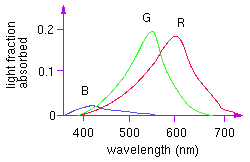
In order to define the perceptual 3D space in a "standard" way, a set of experiments can (and have been) carried by having observers try and match color of a given wavelength, lambda, by mixing three other pure wavelengths, such as R=700nm, G=546nm, and B=436nm in the following example. Note that the phosphors of color TVs and other CRTs do not emit pure red, green, or blue light of a single wavelength, as is the case for this experiment.
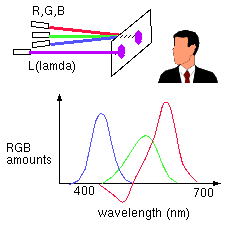
The above scheme can tell us what mix of R,G,B is needed to reproduce the perceptual equivalent of any wavelength. A problem exists, however, because sometimes the red light needs to be added to the target before a match can be achieved. This is shown on the graph by having its intensity, R, take on a negative value.
In order to achieve a representation which uses only positive mixing coefficients, the CIE ("Commission Internationale d'Eclairage") defined three new hypothetical light sources, x, y, and z, which yield positive matching curves:
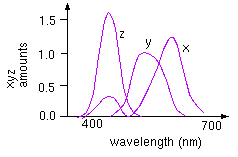
If we are given a spectrum and wish to find the corresponding X, Y, and Z quantities, we can do so by integrating the product of the spectral power and each of the three matching curves over all wavelengths. The weights X,Y,Z form the three-dimensional CIE XYZ space, as shown below.

Often it is convenient to work in a 2D color space. This is commonly done by projecting the 3D color space onto the plane X+Y+Z=1, yielding a CIE chromaticity diagram. The projection is defined as:

Giving the following chromaticity diagram.
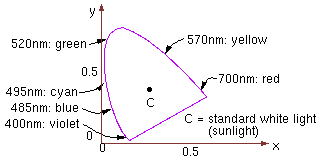
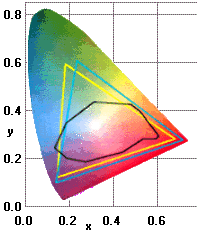
A few definitions:
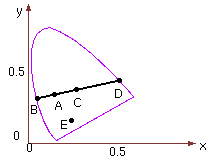
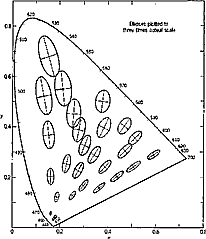
The chromaticity diagram can be used to compare the "gamuts"
of various possible output devices (i.e., monitors and printers). Note
that a color printer cannot reproduce all the colors visible on a color
monitor.
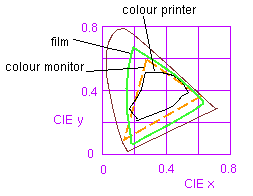
The additive color model used for computer graphics is represented by
the RGB color cube, where R, G, and B represent the colors produced by
red, green and blue phosphours, respectively.
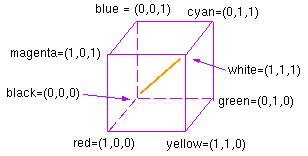
The color cube sits within the CIE XYZ color space as follows.
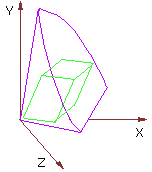
Green paper is green because it reflects green and absorbs other wavelengths. The following table summarizes the properties of the four primary types of printing ink.
| dye color | absorbs | reflects |
| cyan | red | blue and green |
| magenta | green | blue and red |
| yellow | blue | red and green |
| black | all | none |
To produce blue, one would mix cyan and magenta inks, as they both reflect blue while each absorbing one of green and red. Unfortunately, inks also interact in non-linear ways. This makes the process of converting a given monitor color to an equivalent printer color a challenging problem.
Black ink is used to ensure that a high quality black can always be printed, and is often referred to as to K. Printers thus use a CMYK color model.
Monitors are not all manufactured with identical phosphors. To convert
from one color gamut to another is a relatively simple procedure (with
the exception of a few complicating factors!). Each phosphor color can
be represented by a combination of the CIE XYZ primaries, yielding the
following transformation from RGB to CIE XYZ:
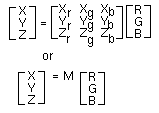
The transformation  yields
the color on monitor 2 which is equivalent to a given color on monitor
1. Quality conversion to-and-from printer gamuts is difficult. A first
approximation is as follows:
yields
the color on monitor 2 which is equivalent to a given color on monitor
1. Quality conversion to-and-from printer gamuts is difficult. A first
approximation is as follows:
C = 1 - R M = 1 - G Y = 1 - BThe fourth color, K, can be used to replace equal amounts of CMY:
K = min(C,M,Y) C' = C - K M' = M - K Y' = Y - K
Several other color models also exist. Models such as HSV (hue, saturation, value) and HLS (hue, luminosity, saturation) are designed for intuitive understanding. Using these color models, the user of a paint program would quickly be able to select a desired color.
To understand the appearance of colors we must understand the neural signals that get sent to the brain. Only since 1950-1960 has the the older trichromatic theory of Young and Helmholz been reconciled with the the apparently competing opponent colors theory of Ewald Hering.
Most of the color phenomena we have discussed up to now can be explained in terms of the response of the three cone types. But we have yet to understand the appearances of color mixtures. For example, an additive mixture of red and green does not appear reddish green, but instead yellow.
We must have a different mechanism, other than simple tristimulus theory, in order to tell each other what colors look like.. For this purpose, in fact, you need four pschological primaries, blue, green, yellow, and red. All hues can be verbally described as combinations of these. For example, orange looks yellowish red, cyan looks bluish green, purple looks redish blue, etc.). How can your brain process the output of the three cone types to obtain the psychological description in terms of four primaries?
Signals to the brain are often comparisons between different receptor responses. For the red minus green chromatic channel (r-g), a net excitation leads to the sensation of red, while a net inhibition leads to the sensation of green.
In the yellow minus blue chromatic channel (y-b), which compares the long wavelength part of light with the short wavelength part, the light that excites either the L or M cones produces an excitation of the cells of the y-b channel. If, however, light excites the S cones, there is inhibition of the y-b cells. If the net result is excitation, the light appears yellowish. A net inhibition makes the light appear bluish.
Maintained by John Loomis, last updated May 16, 1997